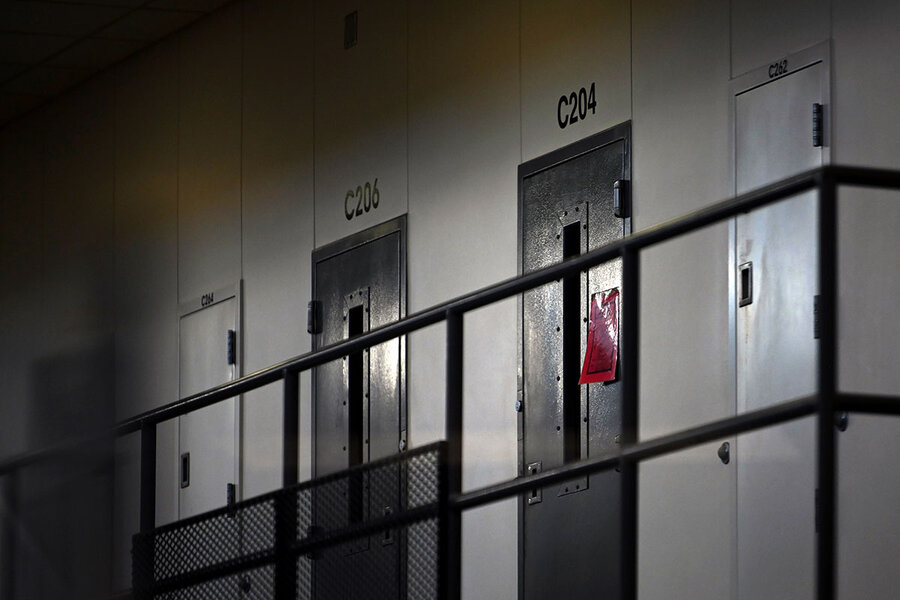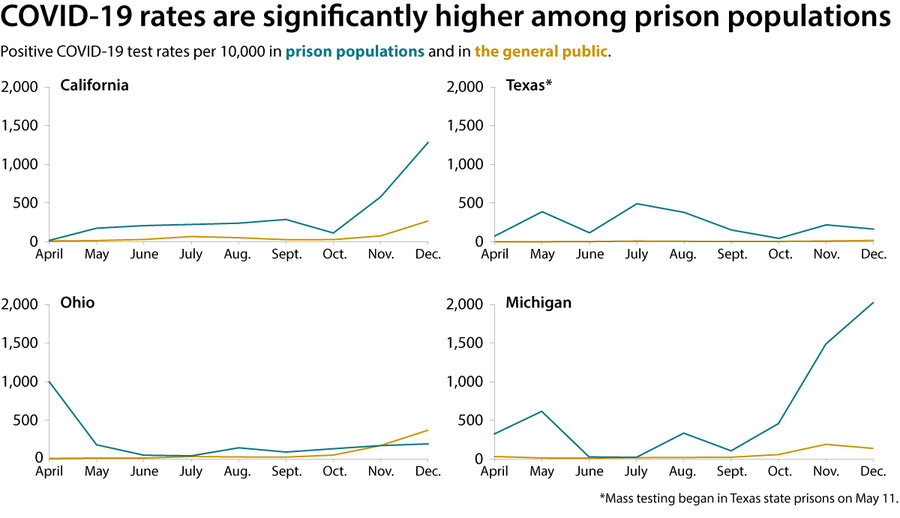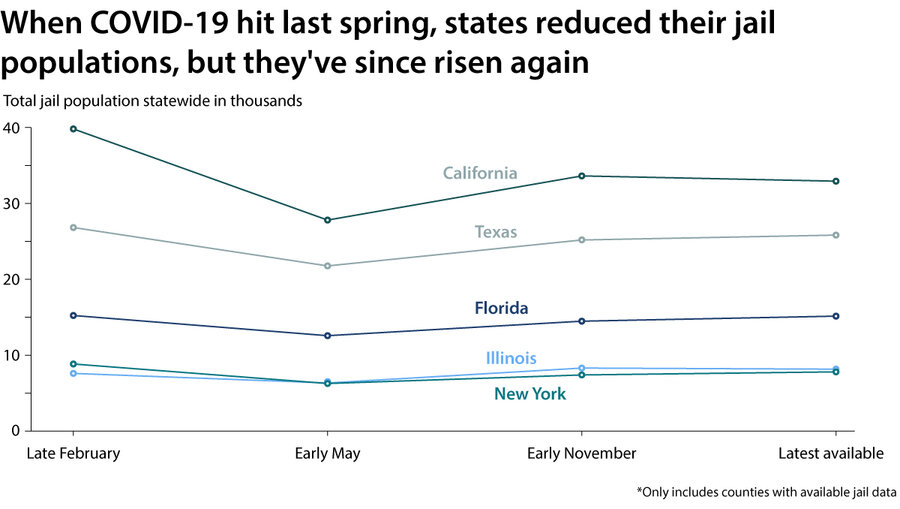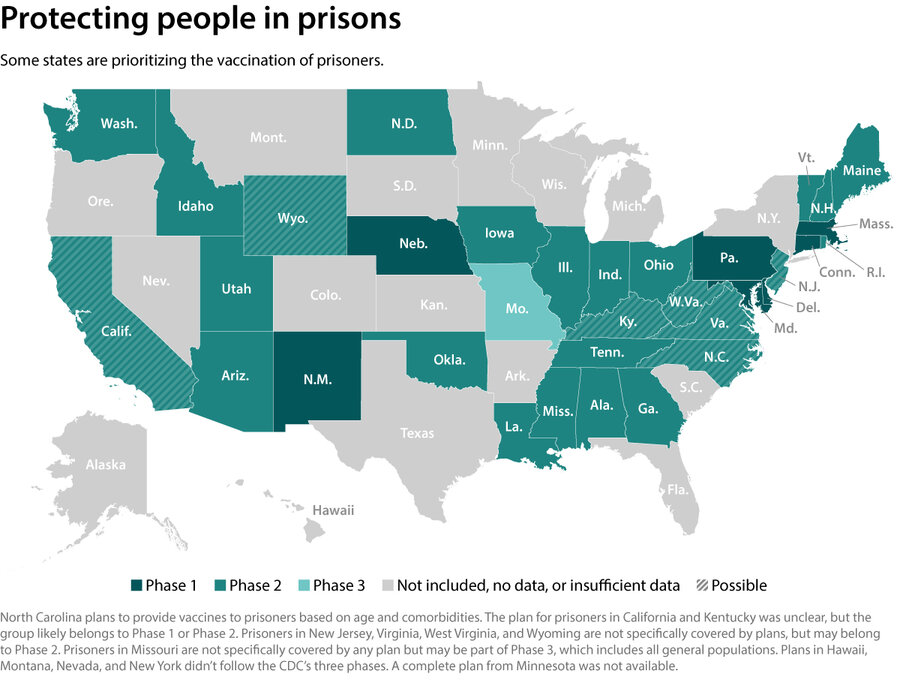Why protecting prisons from COVID-19 is everyone’s problem
Loading...
The COVID-19 pandemic that has devastated the United States has raged with particular ferocity inside prisons and jails. Such facilities are characterized by poor sanitation and health care, and house large concentrations of high-risk individuals; social distancing is nearly impossible.
Among the country’s roughly 2.3 million prisoners, there have been at least 329,000 reported COVID-19 cases behind bars, taking the lives of at least 2,020, according to data tracked by The Marshall Project and The Associated Press – rates that far exceed the non-prison population. By comparison, 380,000 have died in the U.S. overall.
The health care system behind bars was “deeply flawed” even before the pandemic, says Homer Venters, former chief medical officer for New York City’s jails.
Why We Wrote This
Understanding how the coronavirus threatens the lives of prisoners and prison officers is crucial to combating its spread and to safeguarding incarcerated people.
“There wasn’t a lot of evidence-based access to [medical] care to begin with, so when outbreaks hit many of these facilities people were left to fend for themselves,” he says.
Some states have been doing better than others, says Michele Deitch, a professor at the University of Texas at Austin who studies how jails and prisons are run. But generally speaking, “the biggest [health] recommendations have really not been implemented adequately.”
What does work in reducing the risk of spreading COVID-19, say analysts, is depopulating prisons and jails. And while some states did this at the start of the pandemic, prison populations have been ticking back up recently, and so long as that’s the case, says Professor Deitch, “there’s a limit to how much [other] precautions can work.”
For corrections officers potentially exposed to the disease, the pandemic has exacerbated long-standing issues over staffing, training, and pay.
Annual line-of-duty deaths for corrections officers typically number about a dozen. Since March 2020, 115 officers have died from COVID-19 alone, according to Brian Dawe, national director of One Voice United, an advocacy group for corrections officers. (That doesn’t include officer suicides, which were already occurring at a much higher rate than the general population.)
“We’ve got guys and gals doing double shifts day after day after day … who’ve slept in their cars and in their RVs because they were afraid to go to their families,” says Mr. Dawe. “The strain and stress on them, it’s unfathomable.”
Corrections facilities have also contributed to the pandemic outside their walls.
In a report last month, the Prison Policy Institute, a nonprofit research and advocacy group, analyzed the density of incarcerated populations and the increase in pandemic caseloads in that area. It estimates that mass incarceration was responsible for an additional 500,000 cases over the summer.
How corrections systems manage the virus moving forward will be a significant factor in when the pandemic ends here, and how the criminal justice system could be reformed afterward.
For now, vaccination plans for correctional facilities need to be grounded in programs that successfully build trust with incarcerated people, says Dr. Venters, author of “Life and Death in Rikers Island.”
“If the same person bringing you a vaccine is the same person that took you to solitary confinement, or turned a blind eye to your abuse, there would be a tendency to not trust them,” he says.
And until COVID-19 is less prevalent behind bars, the pandemic won’t truly be over in the U.S. no matter how widely vaccines are distributed.
“There would be, a year from now, a series of slow-rolling disasters,” Dr. Venters says, “if we don’t do a good job engaging with people who are incarcerated about taking the vaccine.”
On a positive note, the pandemic could accelerate justice reform. Some jurisdictions are considering making permanent decarceration policies implemented during the pandemic, Reuters reports.
And generally, the pandemic “has created more [public] awareness about the problems inside prisons and jails,” says Professor Deitch. “That does give me hope.”









